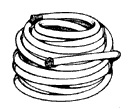Everyday Hazmat User’s Training Guide
Section I—Common USDA Forest Service Activities (continued)
Automotive and Small Engine Services (continued)
Fueling
Fueling chain saws, ATVs, snowmobiles, and vehicles is a common activity at USDA Forest Service units. Diesel fuels and gasoline can be found in aboveground and underground storage tanks. Most USDA Forest Service units have a gas house where smaller quantities of fuel are stored in 55-gallon drums or in containers no larger than 5 gallons. All fuels are flammable or combustible, so take note of the Flammable Liquids or Combustible Liquids guidelines.
Fueling Activities
Most fuels are flammable liquids and contain toxic chemicals. There are certain restrictions on use of containers and how they can be stored; see the Flammable Liquids guidelines for more information.
Wherever possible, reduce the fuel stored at your unit by using local service providers. Remove old gasoline or diesel tanks that are no longer being used. Check all fueling stations to make sure that labels, dispensing hoses and nozzles, product monitoring devices, and overfill protection meet all fire codes.
Transport fuels only in approved containers and only using methods that meet fire codes.
If you use mixed fuels, mix only the amount that you will use for a project or season.
Used Fuels
If you have diesel, gasoline, or mixed fuels that are no longer usable, consider using them as slash fuel or drip torch fuel. Be sure to mark and store them correctly. Do not accumulate more than you can realistically use.
The local National Guard unit may be able to use your obsolete fuel in multifuel vehicles.
Vehicle Washing
Vehicles are commonly washed at maintenance garages and outdoor wash pads. Water quality discharge has become a major regulatory issue, so consider the following suggestions.
All vehicle washing should take place in commercial facilities to avoid wash water discharge concerns.
Wash water discharge may not meet minimum water quality standards because of greases and oils, detergents and soaps, and even weed seeds that may be removed from the vehicle during washing.
If you have extensive vehicle washing needs, consider installing a system designed to meet all water quality standards and to conserve water through a process that captures, cleans, and reuses the wash water.
Consider permanently sealing all floor drains in your vehicle washing areas to avoid discharges of hazardous materials.
Sludge removed from oil-water separators could be hazardous because of the oils and other debris it contains. Collect this sludge and consider it a hazardous waste until you can confirm that it is not; see the Hazardous Wastes guideline.
Wash Water Discharge
Do not wash vehicles on wash racks or wash pads that drain into the sewer system, the ground, or navigable waters unless you have confirmed that water quality and discharge points meet all Federal and State regulations.
Handy Tips
- Use local service providers for all possible vehicle and small engine servicing
to avoid costly product handling. See if a local service provider can come
to your work
center to service vehicles and remove wastes.
- Buy only the quantity you need for a task.
- Use re-refined oil.
- Avoid servicing lead-acid batteries so you donít have to store and handle
acids.
- Post simple handling instructions for used oil, used oil filters, lead-acid
batteries, and used antifreeze; consider using washable oil filters to avoid
discarding
used oil filters.
- Check your community recycling centers to see if they take used oil, lead-acid
batteries, or antifreeze for recycling.
- Use cloth wipes and send them to an industrial laundry for
cleaning; donít throw wipes in the trash.
- Keep lids closed on degreasing units except when they are in use; replace
all degreasing solvents with nonhazardous products.
- Look for green products at the USDA Forest Service green purchasing Web site: /eng/t-d.php?link=everyday_hazmat/green.htm


